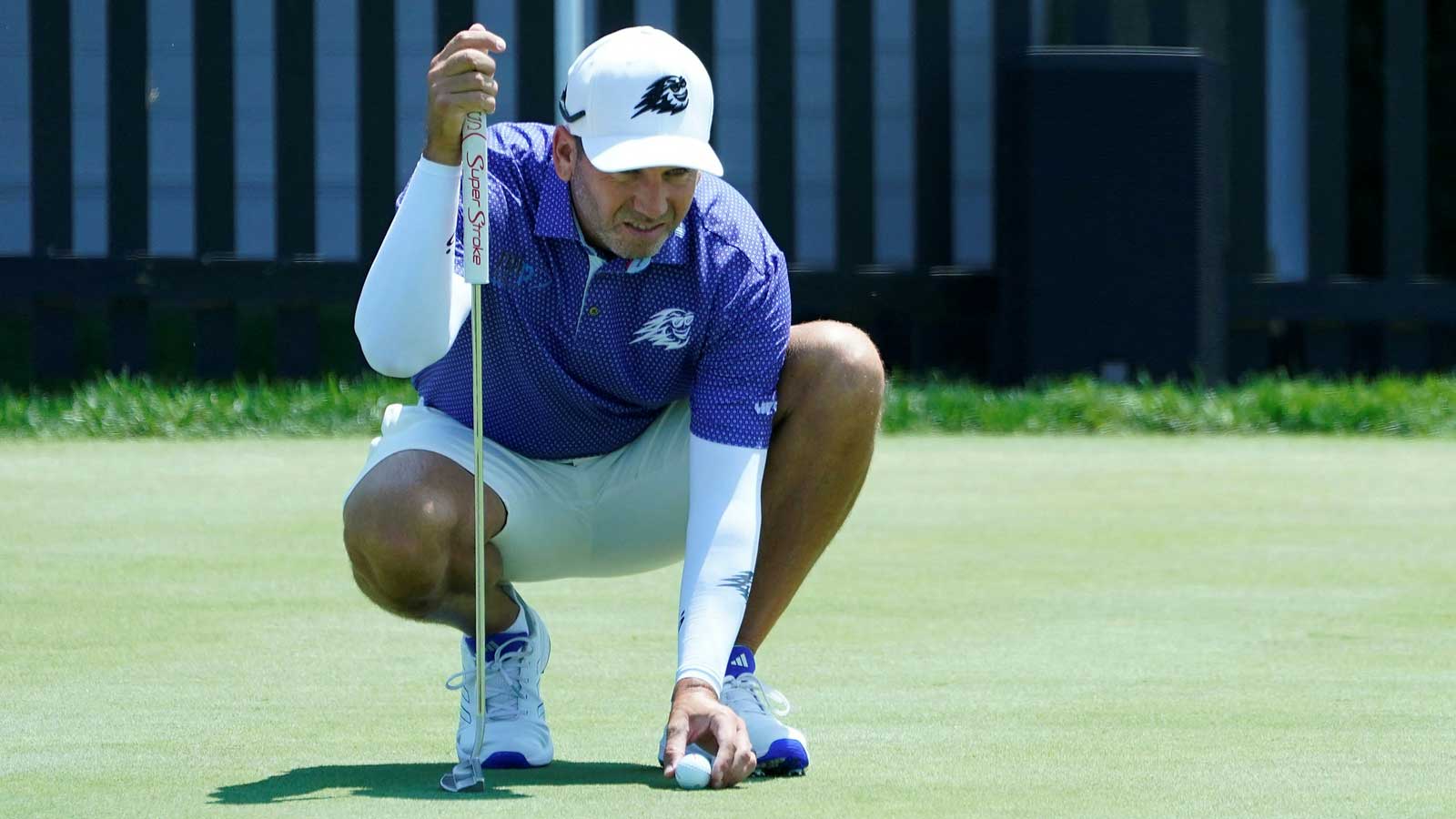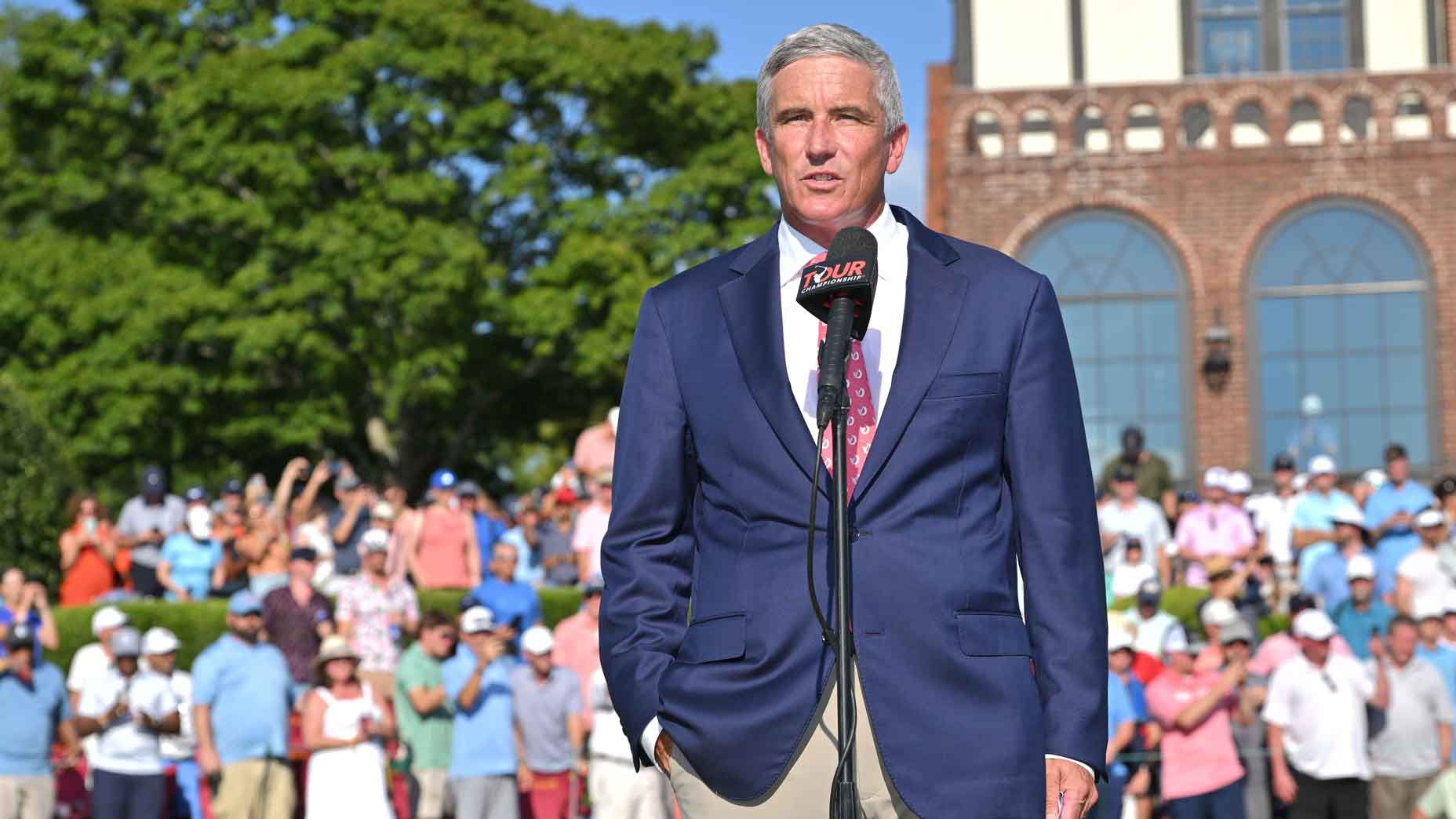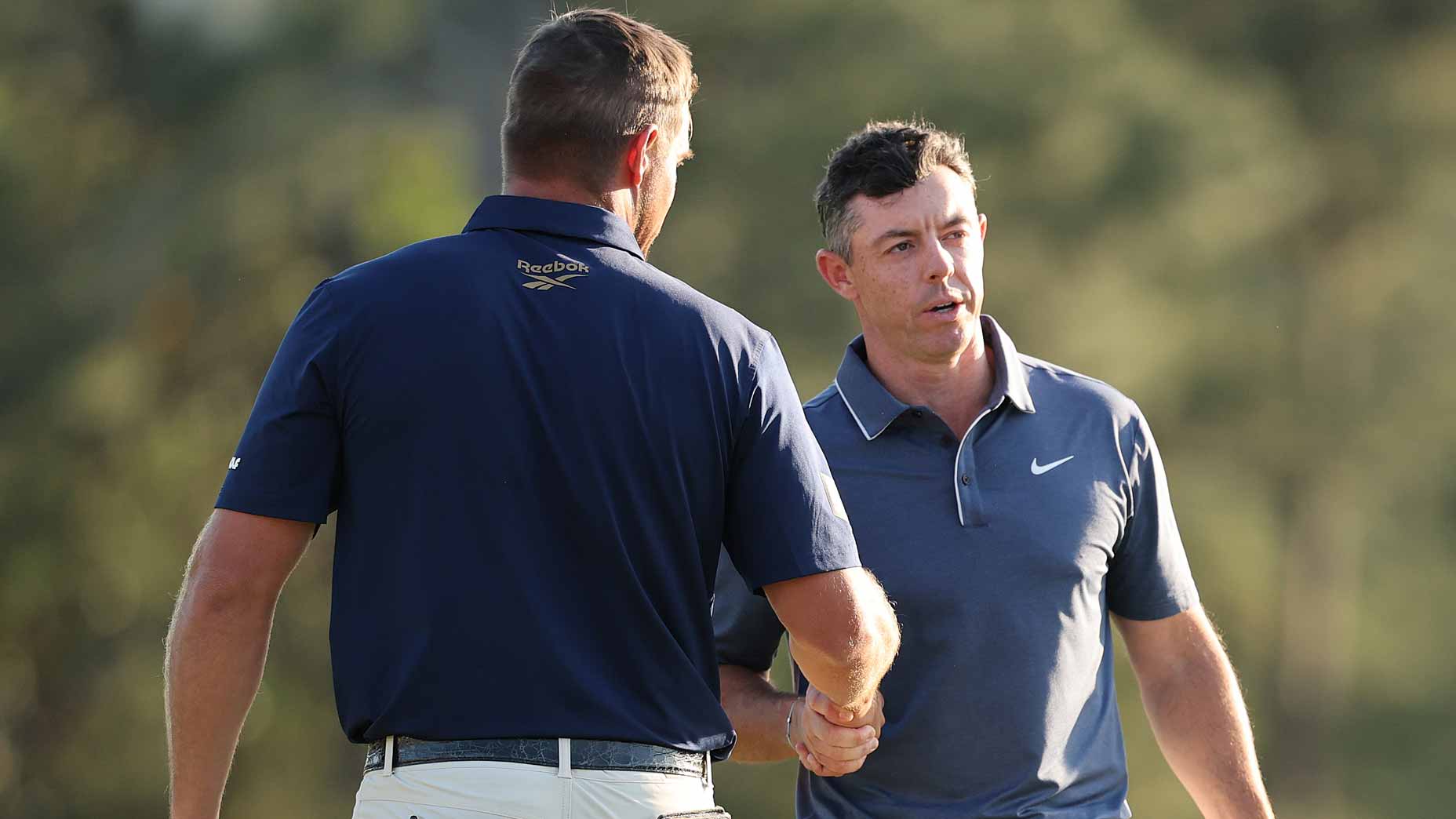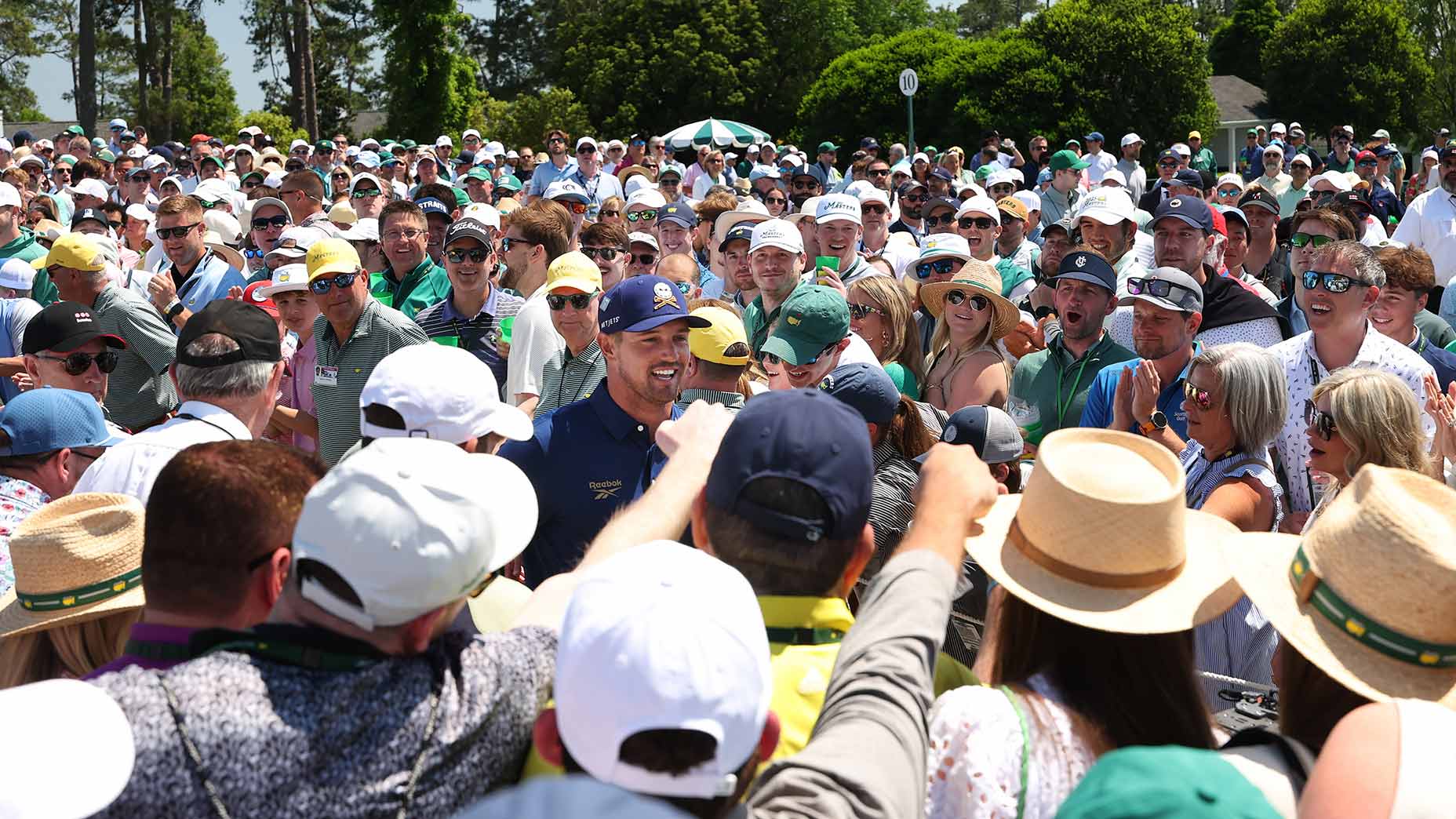LIV players might soon have path back to PGA Tour. But do they even want it?
- Share on Facebook
- Share on Twitter
- Share by Email

Bryson DeChambeau at the LIV Greenbrier event last week.
getty images
BEDMINSTER, N.J. — When LIV Golf and its field of 48 players first descended on Trump Bedminster a little more than a year ago, the event represented LIV’s third-ever tournament and only the second in the U.S., following LIV Portland a month earlier.
Questions swirled around the motives, viability and potential impact of the controversially funded league, many of which were directed to the players LIV had lured away from the PGA and DP World tours with stunningly lucrative contracts.
On the first practice day that week, Paul Casey was asked to explain his about-face on Saudi Arabia’s human-rights record, and Henrik Stenson was asked about his recent ouster from the European Ryder Cup captaincy. After the first round, Phil Mickelson was asked about getting heckled.
LIV Golf was new and shiny and different, but it also still felt like a novelty act hindered by complicated moral and ethical quandaries. As for the notion that the Saudi league might one day harmonize with the PGA Tour? Three letters best summed up the likelihood of that prospect: LOL.
Less than a year later, of course, that’s exactly what happened. On June 6, PGA Tour commissioner Jay Monahan and Yasir Al-Rumayyan, the governor of Saudi Arabia’s Public Investment Fund, which bankrolls LIV, appeared on CNBC and announced a bombshell framework agreement between the Tour and LIV that could, among many once unthinkable scenarios, result in a pathway back to the Tour for players who defected for LIV riches. According to the proposed agreement — which has yet to be ratified — doors would open for “any players who desire to re-apply for membership with the PGA Tour or the DP World Tour following the completion of the 2023 season.”
One question, though, that hasn’t been closely examined: How many LIV players would actually want to come back?
With fans not permitted on the grounds, practice days at LIV events are blissfully laidback affairs. At Trump’s place on Wednesday, the vibe felt especially mellow. Perhaps it was the energy-sapping heat. Or the bucolic horse-country surrounds. Or because the players had competed last week, at the Greenbrier, in the humidity of West Virginia.
Even the presence of the embattled 45th President of the United States didn’t cause much of a stir. Just after 12:30 p.m., Donald J. Trump, who since LIV last visited his property has launched another presidential campaign and thrice been indicted, was chauffeured to the practice range in a golf cart. He was wearing blue slacks, a white polo with the presidential seal and a red MAGA hat. Stitched into the side of his cap were the numbers “45” (done that) and “47” (hopes to do that). Trump already had played nine holes in the morning but wanted more reps in advance of his pro-am grouping with Patrick Reed on Thursday.
As he paced across the range, peering out from under his hat brim, the 77-year-old former POTUS stopped to shake hands and chat with the four members of the Stingers — Louis Oosthuizen, Charl Schwartzel, Branden Grace and Dean Burmester — before continuing to an isolated bay six or seven slots down; even Presidents, it seems, aren’t comfortable practicing next to the pros. One of Trump’s handlers dropped two ball bags next to a patch of chewed-up turf and Trump went to work on his short-iron game, lifting ball after ball — with impressive consistency — into the warm air. Soon his only company was Schwartzel, a few bays down; four or five secret-service agents in colorful golf attire; and a few curious onlookers. An oddly small gallery for arguably the most famous golfer on earth.

All around the property were other familiar faces: Pat Perez dining in the luxurious clubhouse before heading to the 10th tee; Ian Poulter rapping putts through a corridor of tees on the practice green; Bryson DeChambeau, fresh of a tournament-winning 58 at the Greenbrier, and Anirban Lahiri — “Ban” to his LIV stablemates — leading a clinic with juniors on the range.
“If you try something that doesn’t work,” DeChambeau advised the youngsters as he launched balls into another orbit with his new Krank driver, “don’t keep trying it.”
When the clinic wrapped, I asked DeChambeau and Lahiri about the appeal of potentially returning in some capacity to the PGA Tour and whether they agreed with their fellow LIV player Phil Mickelson who tweeted, in part, a couple of weeks ago: “Not a single player on LIV wants to play PGA Tour.”
“I don’t think Phil is too far off with his comments,” said Lahiri, who is 36 and earned more than $9 million on the Tour. “Obviously, it’s individual to individual. There’s 48 people here — there’s at least, if I’m not mistaken, close to 30 of us who were fully exempt when we left. Everybody had different motivations for coming over. I can [only] speak for myself. I probably would not go back. Even if I did, I would probably want to play two or three events.”
Of his decision to join LIV, Lahiri added, “This is Plan A. All of us have moved here with this being our primary place of practicing our profession. When and if [a LIV-Tour partnership] happens, no one really knows, but most of us are really happy here.”
To which DeChambeau, who is 29, said: “Those are wise words from Ban. Like he said, this is Plan A, and I’m not thinking about any other plans as of right now. Would it be fun to go play a couple of events over there? Sure. There are a lot of people and places I respect over there that I’d love to give my blood, sweat and tears for. They just haven’t made that possible yet.”
What will or will not be possible is, of course, still an open question — with many powerful entities demanding answers about how a pact might look. The U.S. Senate. The Justice Department. Tiger Woods, Rory McIlroy, Jon Rahm and the rest of the Tour membership. All have expressed varying concerns about the deal, including whether players who remained loyal to Ponte Vedra should be compensated; whether an accord would, in effect, monopolize men’s professional golf; and how such an arrangement would affect the Tour’s non-profit status.
In a session with reporters at the FedEx St. Jude Classic, in Memphis, on Wednesday, Monahan offered little detail about how the negotiations have been going other than to say that he regretted not informing players of the framework agreement in advance of the public and that he’s optimistic that the Tour and the PIF will come to terms before the Jan. 1 deadline.
He added, “My performance has always been and will continue to be measured based on results and the productivity of the organization…that will be determined when we complete this process. And I am confident that when we complete this process, this will be a rewarding result for the PGA Tour players and our fans.”
One-thousand miles northeast, in Bedminster, the angst and uncertainty saddling the PGA Tour felt a world away. When LIV players sit (or stand) for press conferences, they typically do so with teammates at their side. But on Wednesday morning, Stenson had the podium to himself, which led him to grin and break into song.
“Alllll by mysellllf,” Stenson jokingly crooned, channeling the Eric Carmen tune that Celine Dion helped make famous.
Stenson had other reasons to be in good cheer. He was back at the site of his first and only LIV victory. “Was it only a year ago?” he said. “Yeah, it feels like a lot of things have happened in a year’s time.”
Saudi deal, health and regret: 9 takeaways from Jay Monahan’s private media talkBy: Nick Piastowski
When asked about the possibility of playing events on the PGA Tour, Stenson, who is 47, said he is in no hurry to clutter up his schedule.
“For me personally, if I got 14 LIV events, I got the Open Championship, I might play one or two other tournaments,” he said. “I’m not looking to add another 15 PGA Tour events even if I could.” He added: “I’m not going to answer for the other guys. I can only answer for myself.”
But presumably at least some of his peers would agree, given more than a few players — including Abraham Ancer, Reed and Perez — have cited a lighter playing schedule as one of LIV’s appeals.
When I asked Sergio Garcia about Mickelson’s tweet, he said, “I do feel like it’s the kind of feeling. I think that everyone around here is very happy and very comfortable where they are. Speaking for myself, yes.”
Comfortable is a word you hear frequently out here.
Garcia added: “Like I said, I wanted to come here to LIV not only because I love the product but because I wanted to play less. The possibility of playing PGA Tour comes, I doubt that I would play because I don’t want to play more.”

One of the thorniest questions facing the Tour is how it might reward players who remained loyal. Not all players believe a make-good is necessary — “As far as I’m concerned, they’ve done enough for me,” Jon Rahm said of the Tour — but many do, including Rory McIlroy, who during the height of the LIV war was relentless in his defense of the Tour and said in the wake of the June 6 announcement that he felt like a “sacrificial lamb.”
One potential solution could include Tour loyalists getting a piece of equity in the new PIF-funded, for-profit arm of the Tour, to be called PGA Tour Enterprises. Jimmy Dunne, a Tour policy board member who helped orchestrate the framework agreement, has said the board would need to settle on a “fair mechanism” by which the players could profit.
Money may make the world go round, but it has made the golf world all but spin off its axis.
Ask Harold Varner III, who has never shied away from admitting why he signed with LIV: yep, the dough.
“This money is going ensure that my kid and future Varners will have a solid base to start on — and a life I could have only dreamt about growing up,” he wrote on Instagram last year. Earlier this year, in an interview with the Washington Post, Varner went a step further, slamming his fellow LIV players who said they joined the new tour to help “grow the game.”
“They’re full of s—; they’re growing their pockets,” he told the Post.
As Varner was heading to the Bedminster parking lot on Wednesday afternoon to meet up with his toddler son Liam, aka HV4, I asked him if he had any interest in playing Tour events again.
“I don’t,” he said. “I don’t really care. I wouldn’t have went [to LIV] if I cared so much about being on the Tour and playing the majors. That’s always been my thing.”
He added that he was excited, after this week, to have a month off. The next LIV event isn’t until Sept. 22-24 at Rich Harvest Farms, in Illinois. That will mean a lot of QT with HV4.
When asked how much LIV has communicated to the players about its dealings with the Tour, Varner said, “Not much at all, but I think that’s good. I don’t think everyone should know [what’s happening]. I think that makes it easier to make decisions. The NBA doesn’t make decisions based off what the players think, so I don’t think it should be any surprise [what happened between the Tour and the PIF]. In real sports, you go get your money and you go the f— home.”
Latest In News

Alan Bastable
Golf.com Editor
As GOLF.com’s executive editor, Bastable is responsible for the editorial direction and voice of one of the game’s most respected and highly trafficked news and service sites. He wears many hats — editing, writing, ideating, developing, daydreaming of one day breaking 80 — and feels privileged to work with such an insanely talented and hardworking group of writers, editors and producers. Before grabbing the reins at GOLF.com, he was the features editor at GOLF Magazine. A graduate of the University of Richmond and the Columbia School of Journalism, he lives in New Jersey with his wife and foursome of kids.










